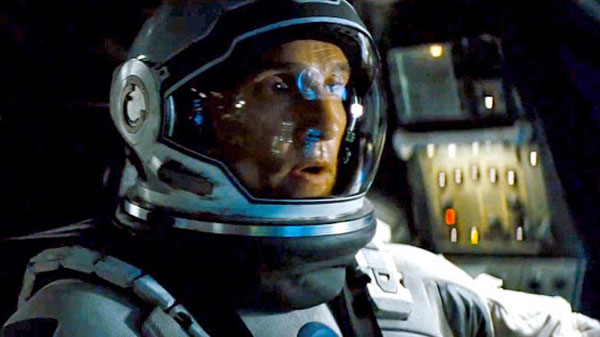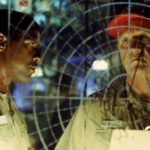Interstellar Review
I want to talk about how well-made Interstellar is.
I want to talk about Hoyte Van Hoytema’s cinematography in director Christopher Nolan’s ambitious, awe-inspiring film; it’s remarkable. Stepping in for regular Nolan contributor Wally Pfister, Van Hoytema establishes an old-fashioned aesthetic full of shots of a decaying Earth and a quietly wonderous beyond.
I want to talk about Lee Smith, Nolan’s regular editor. He turns this three-hour space-set drama into one of the most brisk and thrilling filmgoing experiences of the year. And while the film as a whole, as ambitious as it is, feels rather conventional, Smith zigs when other editors might zag, meaning we get extended passages that are heavy on dialogue and mood-setting as well as one of the most breakneck extended climaxes in recent movie history.
I want to talk about Hans Zimmer—top composer du jour, another Nolan regular—whose organ-filled score carries the majesty of the subject at hand. It’s classic Zimmer, meaning some will find it overbearing and too loud, but its weight is welcome in both dramatic and action-packed moments.
I want to talk about the film’s controversial sound mix. Yes, occasional passages of dialogue are tough to make out, but no more so than any other action film. More notable are the moments during which Smith’s editing makes exhilarating use out of space’s silence (something Alfonso Cuaron’s Gravity, interestingly enough, didn’t really do).
Why lead with this? Because this film is damn divisive, and I totally get why. But the obvious technical expertise at play in Interstellar feels like something we can all agree upon. Right? RIGHT??
The fact is no one can agree about Interstellar, and that’s fine. The film is a little like Darren Aronofsky’s Noah from earlier this year insofar as its flaws are masked by grand ideas and an innate ability to burrow into your brain. Both also are tremendous conversation-starting movies, and both are among my favorite films of 2014.
The film opens in the American Midwest circa 2050. Matthew McConaughey plays Cooper, a widower, father, and NASA pilot who turns to farming after a blight begins destroying the world’s food supply. It’s bleak (and really dusty), but most of the world doesn’t know quite how bad things are about to get. Cooper is perhaps cosmically guided toward a small group of NASA scientists working underground to send a team into space. Their goal: find a new home for humanity because Earth is rapidly becoming truly uninhabitable. In other words, if Cooper and company don’t succeed, we’re finished.
The space-bound team is made up of Cooper, Brand (Anne Hathaway), Romilly (David Gyasi), Doyle (Wes Bentley), and the robot TARS (voice of Bill Irwin). Meanwhile, the elder Dr. Brand (Michael Caine, playing Hathaway’s father and McConaughey’s mentor) is trying to unlock an equation that will make mass space transport possible for those remaining behind on Earth—including Cooper’s distraught daughter, Murph (Mackenzie Foy), who grows up to become a student of Dr. Brand herself (played in adulthood by Jessica Chastain). Should Brand, Murph, and company fail to solve this equation, Plan B states that Cooper and his team colonize the most habitable planet they encounter on the other side of a mysterious wormhole that’s opened up near Saturn.
The plot isn’t complicated, but it’s dense and tough to talk about in too much detail without getting into perceived spoiler territory. What I will say is that it’s heart is intensely focused on the micro despite all the macro stuff on the surface. Wormholes, relativity, fifth dimensions—the film’s ideas are HUGE. And it physically manifests its largeness in the form of deep space’s geography (those waves!) and something literally called Gargantua. But ultimately, Nolan never lets us stray too far from what’s clearly driving him this time around—love, relationships, human connection, and the things we as people can do together. His insistance on hitting those notes aggressively has been/will be a sticking point for some. They certainly lead to some talky, sentimental passages, but I was excited seeing McConaughey, Hathaway, Caine, and the rest of this fantastic cast of actors get to show off some dramatic chops in a Nolan science-fiction movie. It isn’t something you’d expect to work, but my does it. McConaughey in particular gives a sensational performance, and Foy steals every scene she’s in.
I talked up the craft already, but it bears repeating: this movie is just gorgeous. What I’ll take away most, however, isn’t the acting or the images. It’s not the story, the music, or any single scene. I cherish Interstellar, instead, because of how much I’ve wanted to talk about it. It’s not often that such a bold, challenging, frustrating, lovely, fun film comes along, and when it does, I want to tell people to see it. I want to recommend it—all three hours—to everyone I know, so we can talk about it. From the Dust Bowl to Saturn to “beyond the infinite,” this film doesn’t contain a single scene unworthy of intelligent conversation, which is so much more than can be said about 95% of films in general, nevermind major studio fare.
So you can nitpick about the exposition or the sound mix or a certain controversional cameo if you must; I won’t even argue with you. I just want to talk about Interstellar.
















One Response to Interstellar Review